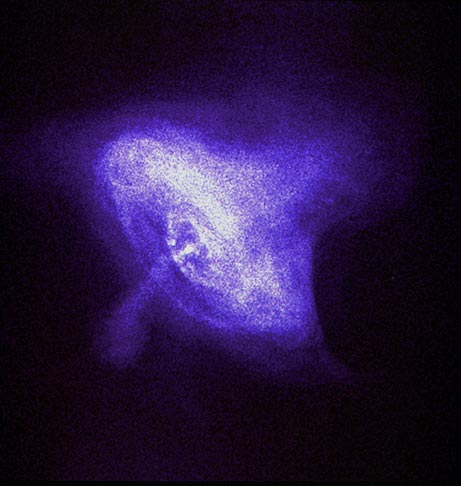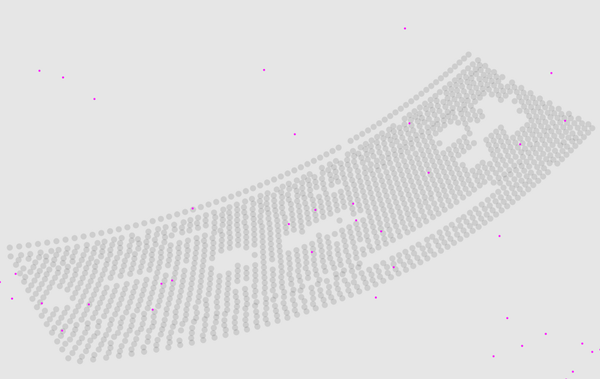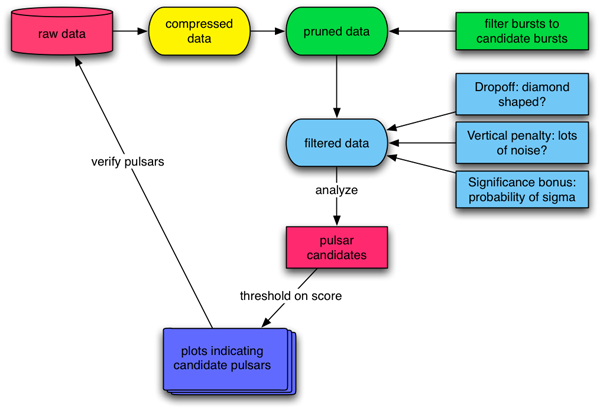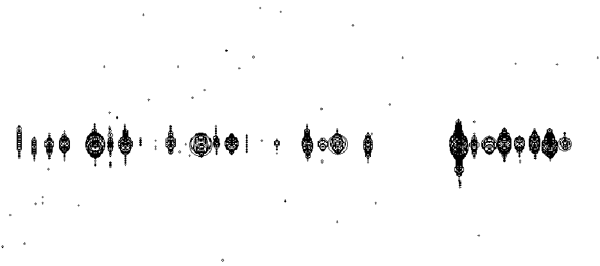Automatic Single-burst Pulsar Detection
This project was done by Steijn Kistemaker, Arjan Nusselder and Nadya Peek during a project for the Astronomical Institute Anton Pannekoek of the University of Amsterdam supervised by Jason Hessels and Maarten van Someren.
Pulsars are very dense rotating radiating stars, which have only recently been discovered in our galaxy. Automatic data processing techniques for detecting pulsars are still in development. This project describes an algorithm for detecting irregular pulsars which do not easily show up in detection techniques relying on the periodicity of a pulsar.

Introduction
A new distributed astronomical data collecting system is being implemented through the Netherlands, Germany, Great Britain and France which will collect up to 1 square kilometer of radio-frequency (wavelengths of around 1 meter) data. The project is called LOFAR, for Low Frequency Array, and is a interferometric array of radio telescopes which will be particularly suited for finding the radio signals transmitted by pulsars, or pulsating stars.
Pulsars are very interesting to astrophysicists because of the extreme conditions they create. They are highly magnetized collapsed massive stars (neutro stars) which emit electromagnetic radiation while rotating, sometimes as quickly as once every couple of milliseconds. When the axis of rotation is orthogonal to our line of sight, we can observe the electromagnetic radiation in the form of periodic radio waves, similarly to how we see a blinking light from a lighthouse. Pulsars have such strong gravitational forces that gravitational radiation, which was predicted but not observed during the conception of general relativity, can be observed and studied.
So far, pulsars have been detected using very large radio telescopes such as the Green Bank Telescope in West Virginia. The amounts of data produced by readings from the GBT were small enough that astronomers would plot the data they gathered and detect pulsars by eye. So far, some 1800 pulsars have been detected, but due to the current positioning of radio telescopes, most of those pulsars have been detected in one particular quadrant of the galaxy. Once the LOFAR is fully operational however, there will be a lot of data from other quadrants, too much to be able to have a human look at it all. To be able to aid the detection of pulsars, it has become very interesting to develop some data-processing methods which will filter data from the radio telescopes and preliminarily detect possible pulsars.
Approach
For the our automated pulsar detection methods, we analyzed radio data collected in the GBT350 survey. The data covers approximately 1000 square degrees of sky visible from the Northern Hemisphere, and is separated into single pointings, each approximately 0.6 degrees in diameter. The observing frequency of the data is between 325 and 375 MHz, and each pointing was observed for 120 seconds. The distance from the earth to the pulsars is measured by dispersion measure or DM. Dispersion measure is not an absolute distance, but uses the dispersion of the signal to calculate how much lays between the source of the signal and the observer. It can be seen as a quantification of the amount of electrons between the observer and the source. The observations have been made between 0 and 1500 DM, but we will only be analyzing up to 300 DM. When observing a pointing with a beam of 0.6 degrees, it is still possible to observe pulsars which are some distance away (up to 3 degrees, depending on the strength and distance of the pulsar).

GBT pointings (grey circles), with RA and DEC as axes. The pink dots are known pulsars.
We do a multiple pass analysis on the data. Firstly, probable RFI and other noise should be removed from the data (per single pointing). Then the remaining data should be analyzed per candidate burst, where the burst context is taken into account when scoring. Each burst then receives a score, a combination of which will define its final ‘probable pulse’ score. This score can easily be thresholded to present candidate pulsars.

An overview of the system
For the time being, we propose 3 different filters over the pruned data which we will combine to produce a score per dispersion measure (DM). The first, dropoff should analyze the shape of the burst and determine whether it looks like astronomical data or noise. The second, vertical penalty should determine how likely a burst is really just noise based on its neighboring bursts. Finally, the significance bonus should reward statistically very unlikely bursts in their scores.
Results

A clearly periodic pulsar
Our algorithm is quite reliably able to detect pulsars, both regular and irregular. We were able to redetect all the known pulsars in the GBT350 survey. Depending on score ranges observed, one will also observe many false positives, but a minimum of false negatives. We have implemented a plotter which will indicate in which DM it is most likely to find a pulsar, aiding the human filtering of candidate plots.

A very weak single burst pulsar
